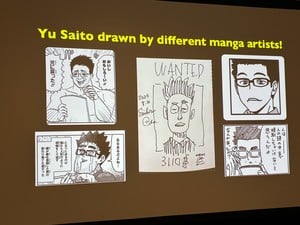All the News and Reviews from Anime NYC 2025
Behind Weekly Shonen Jump: A Conversation with the Editor-in-Chief
by Reuben Baron,

Saito, who started working at publisher Shueisha in 2005 straight out of college and became WSJ's Deputy Editor in 2020 before getting appointed Editor-in-Chief in 2024 (“it feels like it's only been a week,” he noted), is open to many different varieties of “new.” “It could be anything,” he said, “not just art, story, or characters, but something different and new.”
Some readers might dispute how “different and new” some Jump hits feel. One could hear nervous, embarrassed-sounding chatter in the audience when Saito recalled telling Takeru Hokazono (a guest at this year's Anime NYC) about the enthusiastic international response to the first chapter of Kagurabachi — enthusiasm that began out of ironic memes mocking how generic and unoriginal the series looked.
But wherever you fall on how many “new” ideas Kagurabachi offered, it has at least one objectively “new” quality: it's Hokazono's first ongoing manga, and his previous one-shots were also published by Weekly Shonen Jump and its offshoot magazine Jump Giga. This is the sort of “new” that Saito can brag about without argument: Jump's track record of discovering and promoting new talent. “We seek out and serialize manga artists that don't have any track record… In the creative world of manga, it's very difficult for a new artist who has never published anything before to get their foot in the door.”
When launching new series, Weekly Shonen Jump always spotlights them on the cover. Saito said they “might be the only magazine in Japan that does that.” Humorously acknowledging that “It would up our sales even more if we always put One Piece on the cover,” nurturing new talent and discovering fresh hits takes priority over the easy cash-in for Saito and the WSJ crew. He believes that this is so ingrained into the magazine's philosophy that, “even 100 years from now, you'll see a new series from a new creator on the cover of Weekly Shonen Jump.”
On top of finding new creators and series, the role of a manga editor in Japan involves many other responsibilities. Mangaka have such busy schedules at a weekly magazine that they rarely have time to consult on anime adaptations, so editors will often take on such consulting roles instead. Making sure mangaka stick to their deadlines is another big part of the job — one which leads to editors getting portrayed as villains in most manga about the manga industry, something that makes Saito “sad.” He says the most realistic manga depiction of a mangaka and editor is in Taiyo Matsumoto's Tokyo These Days.
Saito finds that fan letters, particularly those sent from overseas, are the strongest positive motivators for keeping manga on schedule. His most extreme story of trying to make a deadline involved Hideaki Soraichi working on a chapter of Gin Tama. “[Soraichi] was so late on deadlines every week. There's one particular time we had to head to the printers with the manuscript, and there's still one completely blank page. At the time, it took about a 30-minute taxi ride to get from the creator's residence to the printer… in the back of the taxi, he drew the blank page. The heroic role I had was to make sure the ink bottle didn't tip over and spill on that blank page.”
As Editor-in-Chief, Saito no longer has the same direct involvement with creators as he had as a regular editor. His role now is more about creating the most positive work-friendly environment overall. He's also had his portrait drawn by a lot of different Jump artists — a PowerPoint slide highlighted a few of these, including a “Wanted” poster by One Piece's Eiichiro Oda.
Aoki asked about the changing face of Jump manga, noting that grittier works like Barefoot Gen used to be published in the magazine that don't fit as much with its current image. Saito contests that Jump has a different feel now, so much as it's just reflecting changes in “what the fans consider interesting.” But Saito says he and his colleagues aren't particularly focused on following trends either — "We're not data analysts crunching numbers.” Thinking a series will be a hit only for it to flop is the most frustrating part of his job, but he tries to keep things positive for those creators by focusing on making their next project a hit.
The best part of being a manga editor, according to Saito? “Being able to connect with people all over the world I would never otherwise have the chance to meet makes me really happy.” He's heartened by the growth of international manga fandom. It's become easier than ever before to get feedback from readers worldwide, and he's always excited to recognize cosplays at conventions like this one. When asked if international creators have a chance to be serialized (or, in one awkward PowerPoint typo, “sterilized”) in Weekly Shonen Jump, he noted that he's been seeing more overseas creators place in manga competitions.
discuss this in the forum (2 posts) |
back to All the News and Reviews from Anime NYC 2025
Convention homepage / archives